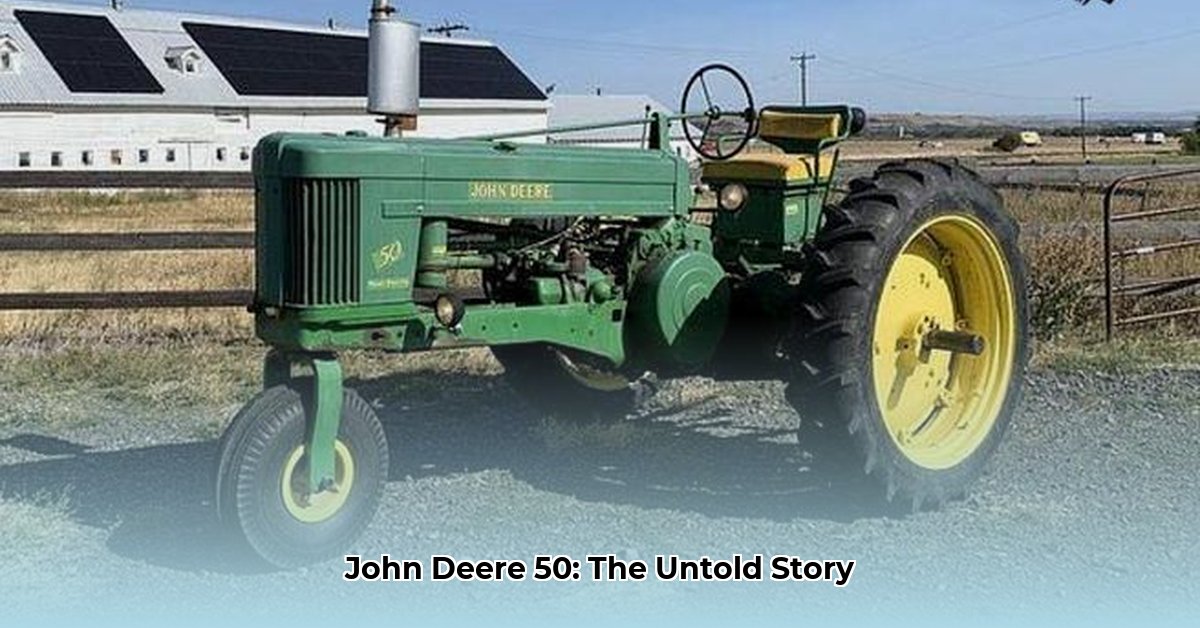
The John Deere 50 tractor, a stalwart of the 1950s agricultural revolution, stands as more than just a machine; it represents a significant advancement in farming technology and a testament to post-war innovation. Produced between 1952 and 1956, this workhorse offered farmers unprecedented flexibility and power, shaping the future of agricultural practices. But what precisely differentiated the John Deere 50, and what enduring legacy did it leave behind? For toy collectors, see more here.
Power Under the Hood: Engine Options and Transmission
The John Deere 50 presented farmers with a revolutionary choice: gasoline, all-fuel, or liquefied petroleum gas (LPG) engines. This flexibility was a game-changer, allowing farmers to tailor their fuel choice to their specific needs and budget. The six-speed transmission, while lacking power steering (optional from 1954), provided farmers with precise gear ratios crucial for diverse fieldwork. The independent power take-off (PTO) further enhanced efficiency when operating implements. This combination of power and maneuverability in a relatively compact design made the tractor impressively versatile. Did this flexibility truly impact farm yields? Further research into operational records from that era could yield compelling answers.
Specifications and Production Numbers: A Quantitative Overview
Precise drawbar and belt horsepower figures for the John Deere 50 remain elusive due to variations in historical records. However, its robust build and impressive power output are undeniable. Approximately 32,574 units were produced, underscoring its widespread popularity among farmers. The tractor's dimensions and weight struck a balance between maneuverability and substantial power, a key element of its success. What factors contributed to such high production numbers? Analyzing contemporary market data, sales figures, and farmer surveys could shed additional light on this.
Fueling Innovation: A Multi-Fuel Approach
The diverse fuel options of the John Deere 50 reflect the post-war era's spirit of experimentation in agriculture. LPG, while exciting, presented its own set of engineering challenges. John Deere's willingness to embrace such technology speaks to the company's forward-thinking approach and commitment to providing farmers with practical solutions. What were the economic and logistical considerations behind the use of LPG as a tractor fuel? Further investigation into historical fuel prices and distribution networks could reveal more.
The Enduring Legacy of the John Deere 50
The impact of the John Deere 50 extends far beyond its production years. Its innovative design heavily influenced subsequent tractor models, cementing John Deere's position as an agricultural technology leader. The tractor's story encapsulates not only technological advancements but also the realities of farming in the mid-20th century. However, how did the initial high cost factor into its overall adoption rate? Analysis of contemporary financial documents could complement the historical narrative.
Areas for Further Research: Unanswered Questions
Despite the wealth of information available, several key questions remain. A detailed analysis of engine specifications for each fuel type could illuminate the engineering challenges faced by John Deere. Similarly, clarifying inconsistencies in horsepower data through investigation of original testing methodologies would provide a more precise picture. These areas require further investigation and collaboration across various disciplines.
Collaboration and Future Research: A Call to Action
The John Deere 50's story continues. Continued research utilizing production records, oral histories from former owners, and the creation of comprehensive museum exhibits are essential for a complete understanding. This research isn't simply a pursuit of historical knowledge; it presents valuable lessons for modern agricultural equipment manufacturers. The collaborative effort by agricultural historians, enthusiasts, collectors, and museum curators will help expand our understanding of this pivotal machine.
John Deere 50: Key Specifications
| Feature | Specification | Notes |
|---|---|---|
| Engine Options | Gasoline, All-Fuel, LP-Gas | Provided fuel flexibility for farmers. |
| Transmission | 6-speed Unsynchronized | Required skill but offered precise control. |
| Power Steering | Optional (from 1954) | Increased comfort and maneuverability. |
| PTO | Independent | Enhanced efficiency of attached implements. |
| Approximate Production | ~32,574 units | Demonstrates significant market success. |
The John Deere 50's legacy continues to inspire and demands further exploration to fully appreciate its impact on the agricultural world.